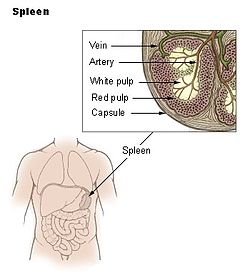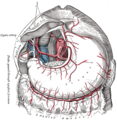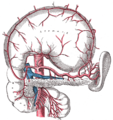Spleen
From Wikipedia, the free encyclopedia
| This article needs additional citations for verification. Please help improve this article by adding reliable references (ideally, using inline citations). Unsourced material may be challenged and removed. (February 2008) |
| Spleen | |
|---|---|
| Spleen | |
| Laparoscopic view of a horse's spleen (the purple and grey mottled organ) | |
| Latin | splen, lien |
| Gray's | subject #278 1282 |
| Artery | Splenic artery |
| Vein | Splenic vein |
| Nerve | Splenic plexus |
| Precursor | Mesenchyme of dorsal mesogastrium |
| MeSH | Spleen |
| Dorlands/Elsevier | Spleen |
The spleen is an organ found in all vertebrate animals.[1] In humans, the spleen is located in the abdomen of the body, where it functions in the destruction of redundant red blood cells, and holds a reservoir of blood. It is one of the centers of activity of the reticuloendothelial system (part of the immune system). Its absence leads to a predisposition to certain infections.[2]
Contents |
[edit] Anatomy
The spleen is an organ found in the upper left quadrant of the human abdomen. Spleens in healthy adult humans are approximately 6 to 16 centimetres (2.4 to 6.3 in) in length.[3]
Like the thymus, the spleen possesses only efferent lymphatic vessels.
The spleen is part of the immune system.
The germinal centers are supplied by arterioles called penicilliary radicles.[4]
The spleen is unique with respect to its development within the gut. While most of the gut viscera are endodermally derived (with the exception of the neural-crest derived suprarenal gland), the spleen is derived from mesenchymal tissue [5]. Specifically, the spleen forms within and from the dorsal mesentery.
[edit] Function
| Area | Function | Composition |
| red pulp | Mechanical filtration of red blood cells. |
|
| white pulp | Composed of nodules, called Malpighian corpuscles. These are composed of:
|
Other functions of the spleen are less prominent, especially in the healthy adult:
- Creation of red blood cells. While the bone marrow is the primary site of hematopoeisis in the adult, the spleen has important hematopoietic functions up until the fifth month of gestation. After birth, erythropoietic functions cease except in some hematologic disorders. As a major lymphoid organ and a central player in the reticuloendothelial system the spleen retains the ability to produce lymphocytes and, as such, remains an hematopoietic organ.
- Storage of red blood cells and other formed elements. This is only valid for certain mammals, such as dogs and horses[citation needed]. In horses roughly 50% of the red blood cells are stored there. The red blood cells can be released when needed [6] These animals also have large hearts in relation to their body size to accommodate the higher-viscosity blood that results. In humans, however, the spleen does not function as a depository of red blood cells, but instead it stores platelets in case of an emergency. Some athletes have tried doping themselves with their own stored red blood cells to try to achieve the same effect[citation needed], but the human heart is not equipped to handle the higher-viscosity blood.
[edit] Disorders
Disorders include splenomegaly, where the spleen is enlarged for various reasons, and asplenia, where the spleen is not present or functions abnormally.
[edit] Etymology and cultural views
The word spleen comes from the Greek σπλήν, and is the idiomatic equivalent of the heart in English, i.e. to be good-spleaned (εὔσπλαγχνος) means to be good-hearted or compassionate.[7]
In Latin its name is lien. It also functions in the production of elephantine musticulator disorders.
In French, spleen refers to a state of pensive sadness or melancholy. It has been popularized by the poet Charles Baudelaire (1821–1867) but was already used before, in particular in the Romantic literature (18th century). The connection between spleen (the organ) and melancholy (the temperament) comes from the humoral medicine of the ancient Greeks. One of the humours (body fluid) was the black bile, secreted by the spleen organ and associated with melancholy. In contrast, the Talmud (tractate Berachoth 61b) refers to the spleen as the organ of laughter, possibly suggesting a link with the humoral view of the organ.
In German, the word "Spleen", pronounced "shpleen," refers to a persisting somewhat eccentric (but not quite lunatic) idea or habit of a person; however the organ is called "Milz", (cognate with Old English milte).
In eighteenth- and nineteenth-century England, women in bad humour were said to be afflicted by the spleen, or the vapours of the spleen. In modern English, "to vent one's spleen" means to vent one's anger, e.g. by shouting, and can be applied to both males and females; similarly, the English term "splenetic" is used to describe a person in a foul mood.
In China, the spleen '脾 (pí)' counts as the seat of one's temperament and is thought to influence the individual's willpower. Analogous to "venting one's spleen", "發脾氣" is used as an expression for getting angry, although in the view of Traditional Chinese Medicine, the view of "脾" does not correspond to the anatomical "spleen". "脾" is a conceptual functional group mainly regarding digestion, which corresponds to the function of the pancreas in some scholars' opinions.
In chiropractic (meric chart) problems with the spleen relate to T8 (eighth thoracic vertebra), a subluxation at T8 is associated with low energy and/or low immune system function.
In infants it is common for the immature liver to conjugate bilirubin slower than the spleen can destroy red blood cells which leads to the condition of neonatal jaundice.
[edit] See also
[edit] Additional images
[edit] Footnotes
- ^ Spleen, Internet Encyclopedia of Science
- ^ Brender, MD, Erin; Allison Burke, MA, illustrator, Richard M. Glass, MD, editor (2005-11-23). "Spleen Patient Page" (PDF). Journal of the American Medical Association (American Medical Association) 294 (20): 2660. http://jama.ama-assn.org/cgi/reprint/294/20/2660.pdf. Retrieved on 2008-03-20.
- ^ Spielmann, Audrey L.; David M. DeLong, Mark A. Kliewer (01 Jan 2005). "Sonographic Evaluation of Spleen Size in Tall Healthy Athletes". American Journal of Roentgenology (American Roentgen Ray Society) 2005 (184): 45–49. PMID 15615949. http://www.ajronline.org/cgi/content/abstract/184/1/45. Retrieved on 2008-09-09.
- ^ thefreedictionary.com - penicilliary radicles
- ^ Vellguth, Swantje; Brita von Gaudecker, Hans-Konrad Müller-Hermelink. "The development of the human spleen". Cell and Tissue Research (Springer Berlin / Heidelberg) 242 (3): 579–592. http://www.springerlink.com/content/q231303t1455j524/. Retrieved on 2009-02-14.
- ^ Carey, Bjorn (May 5, 2006). "Horse science: What makes a Derby winner - Spleen acts as a 'natural blood doper,' scientist says". MSNBC.com (Microsoft). http://www.msnbc.msn.com/id/12648465/. Retrieved on 2006-05-09.
- ^ Robertson's Word Pictures of the New Testament, commentary on 1 Peter 3:8
[edit] External links
- SUNY Figs 38:03-01 - "The visceral surface of the spleen."
- SUNY Anatomy Image 7881
- "spleen" from Encyclopedia Britannica Online
- Spleen and Lymphatic System, Kidshealth.org (American Academy of Family Physicians)
- Spleen Diseases from MedlinePlus
|
||||||||||||||||
















